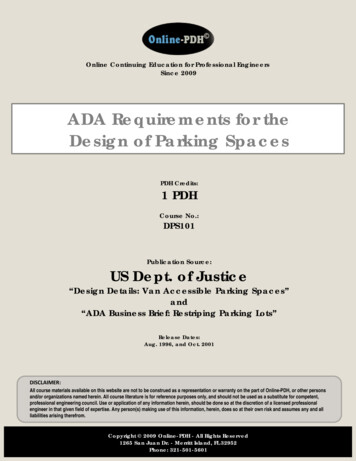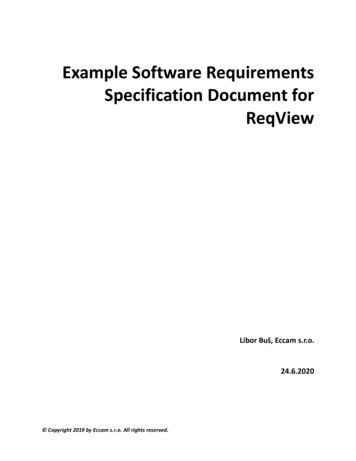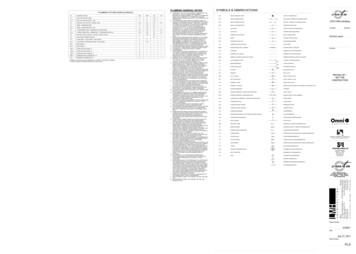
Transcription
Online Continuing Education for Professional EngineersSince 2009ADA Requirements for theDesign of Parking SpacesPDH Credits:1 PDHCourse No.:DPS101Publication Source:US Dept. of Justice“Design Details: Van Accessible Parking Spaces”and“ADA Business Brief: Restriping Parking Lots”Release Dates:Aug. 1996, and Oct. 2001DISCLAIMER:All course materials available on this website are not to be construed as a representation or warranty on the part of Online-PDH, or other personsand/or organizations named herein. All course literature is for reference purposes only, and should not be used as a substitute for competent,professional engineering council. Use or application of any information herein, should be done so at the discretion of a licensed professionalengineer in that given field of expertise. Any person(s) making use of this information, herein, does so at their own risk and assumes any and allliabilities arising therefrom.Copyright 2009 Online-PDH - All Rights Reserved1265 San Juan Dr. - Merritt Island, FL 32952Phone: 321-501-5601
Study Guide for Course on ADA ParkingRequirementsThis Study Guide is a compilation of two ADA documents:1. “Accessible Parking,” [fact sheet] developed by the Mid-Atlantic ADACenter, 2014.2. Excerpts from “A Planning Guide for Making Temporary EventsAccessible to People with Disabilities,” [booklet] ADA National Network,2015.
Call us toll-free1-800-949-4232 V/TTYTitle II and Title III Revised Regulations: Accessible ParkingNational NetworkInformation, Guidance and Training on theAmericans with Disabilities ActFind your regional center atwww.adata.orgFor the most current and accessibleversion, please visithttp://adainfo.us/accessparkingAccessible Parking“easily accomplishable and able to be carried outwithout much difficulty or expense.” Designatingaccessible parking is often readily achievable,and is considered a top priority because itenables many people with disabilities to “get inthe door.”The U.S. Department of Justice (DOJ) issued newregulations under the Americans with DisabilitiesAct (ADA) in 2010. The new rules affect state andlocal governments (Title II of the ADA), as well aspublic accommodations and commercial facilities(Title III). The regulations include the new 2010ADA Standards for Accessible Design, outliningminimum accessibility requirements for buildingsand facilities.Safe HarborThe 2010 regulations include a “safe harbor” forfeatures that already comply with the 1991standards, but may not meet the new 2010standards. For example: A retail store’s parkinglot has a total of 250 parking spaces; incompliance with 1991 standards, the lot includesseven accessible spaces, one of which is vanaccessible. The 2010 standards would requiretwo van-accessible spaces, but the store doesnot have to modify its parking lot to provide theadditional space until the lot undergoes aplanned alteration (re-striping, re-surfacing, etc.)after March 15, 2012. If the lot is altered afterthat time, it will then be brought into compliancewith the 2010 standards, to the maximum extentfeasible.Existing FacilitiesNew construction projects must meet minimumstandards with very few exceptions; alterationsare also subject to strict requirements, althoughthey may be more affected by existing structuralconditions. Existing buildings and facilities whichare not undergoing planned alterations areviewed a little differently.Title II: Program AccessState and local government agencies that offerprograms, services, or activities in existingfacilities need to make sure that people withdisabilities can gain access and participate inthese activities. There are a variety of ways thatagencies can ensure access to programs, butmaking structural improvements is oftennecessary.How many accessible parkingspaces are needed?One of every six accessible parking spaces, orfraction thereof, must be “van-accessible.” Forexample: A parking lot with 400 total spacesneeds eight accessible spaces, and two of thoseeight spaces must be van-accessible.Title III: Barrier RemovalBoth commercial facilities and publicaccommodations must follow standards for newconstruction and alterations. Additionally, publicaccommodations (private businesses that areopen to the general public, like retail stores,restaurants, banks, parking garages, and manyothers) must remove barriers when it is “readilyachievable” to do so; readily achievable meanswww.adata.orgAccessible spaces must connect to the shortestpossible accessible route to the accessiblebuilding entrance or facility they serve.12014
Title II and Title III Revised Regulations: Accessible ParkingTotal Number ofParking Spaces inParking Facility (Lotor Garage)Minimum Number ofAccessible ParkingSpaces Required1 - 25126 - 50251 - 75376 - 1004101 - 1505151 - 2006201 - 3007301 - 4008401 - 5009501 - 10002% of total1001 and over20, plus 1 for each100, or fractionthere of, over 1000adjacent lot needs 20 accessible spaces (four ofwhich need to be van-accessible), and theremote lot needs 25 accessible spaces (five ofwhich need to be van-accessible). Sinceaccessible spaces need to be as near as possibleto the facilities they serve, the 45 accessiblespaces (including nine van-accessible) can belocated in the lot adjacent to the stadium.Medical FacilitiesCertain types of medical facilities need moreaccessible parking. Hospital outpatient facilities need 10% ofpatient/visitor spaces to be accessible. Rehabilitation facilities that specialize intreating mobility-related conditions andoutpatient physical therapy facilities need20% of patient/visitor spaces to beaccessible.The number of van-accessible spaces is still oneof every six accessible parking spaces, or fractionthereof.Where a parking facility serves multiple buildingsor accessible entrances, accessible parkingspaces should be dispersed to enable people topark near as many accessible entrances aspossible. For example: A shopping center hasfifteen stores, each with a separate entrance.There is one large parking lot with 1000 spaces.The twenty accessible parking spaces should bedispersed to provide some options for people topark close to the different stores.For example: An outpatient physical therapyfacility has a parking lot with 50 total spaces foremployees only. Following basic requirements,that lot will need two accessible spaces, one ofwhich will be van-accessible. A separate lot with200 total spaces is provided for patients andvisitors; this lot will need 40 accessible spaces,seven of which will be van-accessible.ExceptionsWhere separate parking facilities serve the samebuilding or entrance, accessible spaces may begrouped together, as long as the number ofspaces provided is determined according to eachof the separate parking facilities. For example: Asports stadium has an adjacent parking lot with1000 spaces and a separate parking lot severalblocks away with an additional 1500 spaces. Thewww.adata.org Parking facilities that are used exclusively forbuses, trucks, delivery vehicles, lawenforcement vehicles, and vehicularimpound are not required to includeaccessible spaces, but if such lots areaccessed by the public (e.g. impoundedvehicle retrieval) then an accessiblepassenger loading zone must be provided.22014
Title II and Title III Revised Regulations: Accessible ParkingWhat do accessible parking spaces look like?Additionally, van-accessible spaces, theirassociated access aisles, and the vehicular routesserving them must provide vertical clearance ofat least 98 inches to allow for the height oftypical wheelchair lift-equipped vehicles.Dimensions (all dimensions are minimums):Accessible parking spaces are eight (8) feet wide;van-accessible spaces are eleven (11) feet wide.Access aisles for either type of space are five (5)feet wide. These adjacent aisles, which can beshared between two spaces, provide room forindividuals to deploy vehicle-mountedwheelchair lifts and/or unload and use mobilitydevices such as wheelchairs, walkers, etc. Analternate design allows a van-accessible space tobe eight (8) feet wide if the adjacent access aisleis also eight (8) feet wide.SignsAccessible parking spaces must be identified bysigns that include the International Symbol ofAccessibility. Signs at van-accessible spaces mustinclude the additional phrase “van-accessible.”Signs should be mounted so that the lower edgeof the sign is at least five (5) feet above theground. This helps ensure visibility both formotorists and local enforcement officials.Access aisles must be marked (e.g., painted withhatch marks) to discourage parking in them. Thisis especially important where the alternatedesign is used and an access aisle at a vanaccessible space is the same size as the space.Exceptions Parking lots that have four or fewer totalspaces do not need to designate theaccessible space with a sign. This means thatfor the purposes of local enforcement (atleast in most jurisdictions), anyone, with orwithout a disability, can park in the accessiblespace. This is intended to excuse very smallentities from having to reserve 25% to 100%The surface of accessible spaces and access aislesmust be smooth, stable, and virtually level in alldirections to ensure safe use for people withdisabilities, including those who must load,unload, and use wheeled mobility devices.www.adata.org32014
Title II and Title III Revised Regulations: Accessible Parkingof their available parking for individuals withdisabilities. Residential facilities where parking spacesare assigned to specific dwelling units arealso exempt from the requirement to postsigns at accessible spaces.Note that these two exemptions are only relatedto signs; accessible parking spaces must still beprovided in appropriate numbers and with otherrequired features (minimum width, etc.).have their own requirements, which may bemore specific or more stringent in some ways.Each state also establishes criteria andprocedures to issue accessible parking permits(often in the form of distinctive license plates orplacards) to individuals with disabilities.Enforcement activities related to these issues(fraudulent use of permits, illegal parking inaccessible spaces, etc.) are typically carried outby state and local authorities, such as city policedepartments.MaintenanceOther requirements may be relevant in differentsituations or under different laws. For example,the Fair Housing Act requires covered housingproviders to make “reasonableaccommodations” for residents with disabilities,which could mean reserving a parking space for aspecific individual.It is important that accessible features bemaintained, and outdoor spaces can beespecially challenging because of weather andother conditions. Accessible parking spaces,aisles, and routes should be maintained in goodrepair and kept clear of snow, ice, or fallen leafbuild-up.Other Laws, OtherRequirementsThe ADA establishes these requirements toensure that when parking facilities are providedby entities covered by Title II or Title III,accessible spaces with certain features areavailable. Many state and local governmentsContent was developed by the Mid-Atlantic ADA Center, and is based on professional consensus of ADA expertsand the ADA National Network.401 North Washington Street, Suite 450Rockville, MD 20850Toll Free: 800-949-4232 V/TTY (DC, DE, MD, PA, VA, WV)Local: 301-217-0124 V/TTYFax: 301-251-3762http://www.adainfo.org/This information product was developedunder grants from the Department ofEducation, NIDRR grant numbersH133A110014 and H133A110017.However, the contents do not necessarilyrepresent the policy of the Department ofEducation, and you should not assumeendorsement by the FederalGovernment. Copyright 2014 ADA National Network. All Rights Reserved.May be reproduced and distributed freely with attribution to ADA National Network (www.adata.org).www.adata.org42014
A Planning Guide forMaking Temporary EventsAccessible to People withDisabilities2015For the most current and accessible version, pleasevisithttp://adainfo.us/temporaryevents
AcknowledgmentsThe content for this planning guide was adapted from the Accessible Temporary Event, APlanning Guide, published in 1998 by the Center for Universal Design at North CarolinaState University in collaboration with the Southeast ADA Center (formally named theSoutheast DBTAC). The authors of this original guide generously permitted substantialrevisions to content to ensure accuracy of content and improve readability. Authors andeditors of original guide included Ronald L Mace and Rex J. Pace, Leslie C. Young, andKaren Olander.The development of the current version was facilitated by the ADA KnowledgeTranslation Center (ADAKTC) at the University of Washington, specifically by;Editors: Cynthia Salzman and RebeccaMatter Editing assistant: AdityaGanapathiraju Graphic designer: Greg OwenExpert reviewers from the ADA National Network who ensured accuracy of contentinclude Troy Balthazor, Peter Berg, Jan Garrett, Karen Goss, and Michael Richardson. Aspecial thanks to Nancy Horton for her careful review and editing on multiple sections.www.adata.orgi2015
IntroductionStreet festivals, craft fairs, music events, sporting events and home shows are buta few of the many temporary events that take place every day in communitiesboth large and small throughout the nation. Temporary events celebrate andsupport a "sense of community" and must encourage participation by all people.This guide provides information to assist planners, managers, operators andbuilding owners in making temporary events accessible to people with disabilities.This guide acquaints the reader with: The value of making temporary events accessible. An overview of the law. Planning strategies to help prevent discrimination. Typical barriers encountered by people with disabilities and solutions forremoval. Methods of locating and coordinating available resources to achieveaccessibility.This guide addresses most questions about how to host an accessible temporaryevent. However, if you have additional questions, please call your regional ADACenter for more information at 1 800 949-4232.--The Americans with Disabilities Act (ADA) is part of our largercivil rights tradition which recognizes and celebrates diversityand strives to include all members of our society. It is in thisspirit that accessibility should be embraced.www.adata.org22015
PARKINGTo use parking spaces safely, people with wheelchairs or other mobility aids need more spacethan is available at typical non-accessible parking spaces. Each accessible parking space must beequipped with a level access aisle to provide adequate space for car doors and van lifts to openand for users to maneuver. To conserve on space, two parking spaces may share one accessaisle (Figure 5).Sign with the internationalaccess symbol designatingspace for accessible parkingAccess aisleshared by twoparking spacesFigure 5Sign with accesssymbol and text thatreads “van-accessible132" minimum widthParking Spaces and Access AislesAs many states have additional design requirements for accessible parking spaces, it isadvisable to check your state and local building codes to ensure that your accessible parkingspaces comply with both the ADA and state/local requirements. Accessible parking spaces mustbe as close as possible to a main event site or building entrance and be connected to thatentrance by a smooth, level path without curbs or obstructions, i.e., an accessible route.
Number of Accessible Parking Spaces RequiredAt a minimum, there should never be fewer accessible parking spaces than specified inthe ADA Standards (Table 1). Of these, at least one in every six accessible parking spacesmust be “van accessible.” Van spaces, to be usable, must be wider than those designedfor cars.Table 1: Number of Accessible Parking spaces as Specified in the ADA StandardsTotal parking spots inlotMinimum numberof accessible spaces required*1 to 25126 to 50251 to 75376 to 1004101 to 1505151 to 2006201 to 3007301 to 4008401 to 5009501 to 10002 percent of total1001 and over20 plus 1 for each 100 over 1000*Note that one of every six accessible spaces, or fraction of six, must be van accessible.For example, if eight accessible spaces are required, two of those eight spaces must bevan accessible.Accessible VansTo provide sufficient room to deploy a lift, van accessible spaces should be at least 132inches wide. For events catering to a specific audience, the number of accessible spacesmay have to increase beyond the minimum if the event is directed toward a populationconsisting of a large number of people who have mobility disabilities, for example, afunction specifically for people who are older.LocationGeneral: Accessible parking spaces must be level and adjoin an accessible route toentrances. Accessible parking spaces should be placed as close as possible to theaccessible entrance served by the parking area to minimize the need for a person with adisability to travel long distances to merely arrive at the entrance.Ideally, all parking areas should have accessible spaces. However, if one lot is closer tothe event entrance, it may be best to locate all accessible spaces in that lot. Coveredparking or unloading areas should be available for people with disabilities, who oftentake longer to get into and out of vehicles.www.adata.org192015
Parking Garages: Parking garages may be problematic because the vertical clearance atthe entrance may be too low to accommodate personal vans equipped with raised roofs,a feature on many accessible vans. As stated in the Standards, vertical clearance for vanaccessible parking spaces and the vehicular route to them is 98 inches minimum. Somepersonal use vans require even greater clearance, thus a vertical dimension greater than98 inches is recommended. (Figure 6).Figure 6Van-accessible spaces may be provided in alternate locations outside the garage, but asclose as possible to an accessible entrance and at no additional inconvenience to thedriver/passenger with a disability.Off-Site Parking: If a significant portion of or all parking is located in areas not adjacentto the event site, accessible routes must be provided to and from accessible parkingspaces in these areas. If the accessible route includes walks, streets, or parking facilitiesnot under the control of the event organizer, it may be necessary to make priorarrangements to ensure that accessible spaces and routes to them are available.Many of the temporary parking and walkway solutions presented in this chapter can alsobe used in off-site areas. One of the most critical issues is the use of curb ramps forcrossing streets and parking lots. It may be possible to request that curb ramps beinstalled or to use strategically placed portable ramps as needed.It may be best under these circumstances to create accessible, temporary parking on-siteand indicate its availability both on directional signage and in publicity material.www.adata.org202015
It may also be possible to use accessible vans or buses to shuttle people from outlyingparking areas. This may be a large commitment of resources for an event if the use ofshuttles is not already being planned for the benefit of other event participants.However, if a shuttle service is planned, the shuttle must be accessible and accessibleparking spaces must be available in lots served by the shuttle.Parking SignageEach accessible parking space should be clearly marked with a vertical sign displaying theaccessibility symbol. Wider spaces for vans should be designated as “van accessible.”Signs for accessible parking must be positioned in strategic locations along the site ifthose spaces are not located within the general parking areas. It may be necessary todesignate accessible parking along the street when parking lots have severe grades orparking garages have low vertical clearances.Upgrading Out-of-Date Accessible Parking SpacesAccessible parking spaces that were built before passage of the ADA may not conform tocurrent standards. The most common problems are insufficient number, narrow accessaisles, and spaces that lack or have improperly designed curb ramps.These problems should be corrected as much as possible to meet the Standards. Ifpermanent changes are not possible or cannot be made in time for an event, temporarysolutions should be made.Access Aisles: Many access aisles are too narrow, i.e., less than 60 inches wide. To solvethis you can block off the entire adjacent parking space and add that space to the accessaisle, thus increasing the area available in which to maneuver a wheelchair or mobilityaid. This also is a good method for providing additional space around an existing curbramp that projects into access aisles.Curb Ramps: Many existing curb ramps have slopes that are too steep, have too muchsurface warp or cross slope, and have insufficient room for a person using a wheelchairto turn out of the ramp onto a level area. These conditions are dangerous and can causemany who use manual wheelchairs to tip and fall.A few solutions to address problem curb ramps include: Adding a temporary ramp at another location even if it is necessary to create anew access aisle. The easiest method is to designate an entire parking space forthis purpose because no additional striping of the lot is necessary. Installing edge protection where none exists (Figure 7).www.adata.org212015
Figure 7Some people in manual wheelchairs, power wheelchairs, or scooters may be able to usesteeper curb ramps (short run ramps) if the slope of the ramp is between 1:8 and 1:10for a maximum rise of three inches or between 1:10 and 1:12 for a maximum rise of 6inches. However, longer ramps are dangerous if they have a slope greater than 1:12.Exposed drop-offs on curb ramps where no side flares are provided are a hazard,especially when crowds are present. Anyone could accidentally travel off the edge of theramp and twist an ankle due to the abrupt level change. This condition is especiallyhazardous for people using wheelchairs who could be pitched out of their wheelchairsonto the pavement.Railroad ties, planters, masonry blocks, and similar large objects set along the edge of anexposed drop-off can provide a warning and a physical barrier. Such objects shouldproject at least two to four inches above the surface of the ramp. The best method toprevent an actual fall is to securely attach a permanent feature such as a return curb orside flare to the exposed edge of the ramp.Creating Temporary Accessible Parking SpacesWhen necessary, temporary accessible spaces can be created in permanent paved lots,dirt lots, or fields.Existing Parking Lots: Choose spaces that are level, close to an accessible entrance andnear existing curb ramps. Mark or block off an existing parking space with cones,barricades, or pavement marking tape to create a new access aisle and use theaccessibility symbol to designate the accessible spaces. If no existing curb ramps areavailable and the new parking spaces border on the sidewalk, place a portable curb rampin the temporary access aisle to gain access to the sidewalk level (Figure 8).www.adata.org222015
Figure 8Temporary Parking Lots: Grass fields or dirt lots used as temporary parking areas usuallyhave no marked spaces. Most likely, participants will arrive and be directed to a parkingspace. Accessible spaces must be created and held in reserve for people with disabilities.Accessible parking spaces should be located where the surface is firm and stable. Dirtshould be hard and compact and grassy areas closely cut to ground level. Loose sand,gravel, and overgrown grassy areas are too difficult to travel across for many peopleusing wheelchairs or those who walk with difficulty. Sites that become slippery or muddywhen wet will not be usable by everyone. If it is possible to find a paved lot with anaccessible route, locate accessible parking there.As with all accessible parking, those designated in temporary lots should be level andnear accessible entrances. The space should be laid out in accordance with the Standardsand identified with the accessibility symbol. Use crowd control fences, traffic cones,and/or similar barricades to set aside accessible parking areas, and designate each spacewith a sign displaying the accessibility symbol. Create an accessible route from theparking access aisles to the event entrance.You may need to place plastic or rubber matting over unstable natural surfaces to makethem navigable for short distances (see “Natural Surfaces” in Chapter 4).People using wheelchairs should not have to travel behind parked cars or cross vehiculartraffic lanes. If this is unavoidable, the pedestrian route (especially where the routecrosses traffic lanes), access aisles, and parking spaces should be clearly defined.Methods and materials to use include chalk or aerosol paint, ropes and stanchions,crowd control fences, and barricades at key points.www.adata.org232015
DisclaimerThis information product was developed under a grant from the Department ofEducation, NIDRR grant number H133A11001 4. However, the contents do notnecessarily represent the policy of the Department of Education, and you should notassume endorsement by the Federal Government.Suggested citationADA National Network. (2015). A Planning Guide for Making Temporary EventsAccessible to People with Disabilities [booklet]. Copyright 2015 ADA National Network. All Rights Reserved.May be reproduced and distributed freely with attribution to ADA National Network(www.adata.org).
published in 1998 by the Center for Universal Design at North Carolina State University in collaboration with the Southeast ADA Center (formally named the Southeast DBTAC). The author










